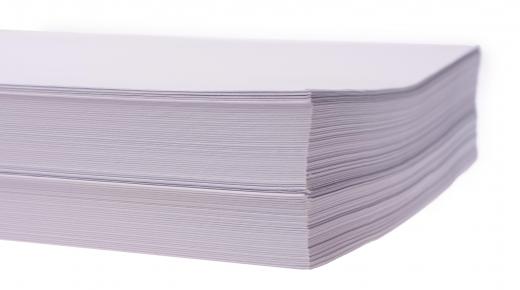A paper ream is a package of 500 sheets of paper of the same quality and style that have been cut to the same size. Consumers often purchase paper in the form of reams, while printers may work in even bigger volumes. This amount is also used as unit of base measurement for calculating the weight of paper, which is a reference to its density. Weight is usually indicated with the pound symbol (#), often on the endcap of a ream so that consumers can refer to this information when selecting paper.
Originally, a paper ream was made up of 20 quires, sheaves consisting of 24 sheets of paper, meaning that a ream actually contained 480 sheets. The definition of “quire” itself has also changed through the ages, but this is an entirely separate issue. To add to the chaos, printers usually purchased reams that contained 516 sheets of paper, to account for potential wastage. Ultimately, many paper companies adopted a 500 sheet standard to reduce confusion.

It is still possible to find a so-called “short ream” of only 480 sheets, however. Short reams are more common with fine or unique papers, but they do crop up in the realm of office supplies as well. Consumers should check for a label that will indicate whether or not a package of paper is a short ream. This can become especially critical for shoppers who are purchasing paper by the case, as a case of ten short reams will fall short of the 5,000 sheets of paper one would expect.
As discussed above, the paper ream is also used to measure paper density. When writing paper is labeled as 20#, for example, it means that a stack of 500 sheets that measure 17 by 22 inch (36 by 56 centimeter) weighs 20 pounds (9 kilograms). Other types of paper use different base sizes. In countries that use the metric system, many paper companies standardize this measurement, using 1 square meter as the basis size for a ream when determining weight, no matter what kind of paper it is. Weights can get confusing, since the paper is often cut after its weight has determined; this explains why a ream of 35# bond, for example, does not actually weigh 35 pounds (16 kilograms).
The weight of paper is an important concern for many people. Some weights, for example, will not fit through regular office printers, while others are too flimsy for certain tasks. Many paper companies offer base styles in a number of weights, allowing people to choose the one most suited to their purpose, whether it is a formal wedding invitation or a business letter.
Ever since she began contributing to the site several years ago, Mary has embraced the exciting challenge of being a About Mechanics researcher and writer. Mary has a liberal arts degree from Goddard College and spends her free time reading, cooking, and exploring the great outdoors.

